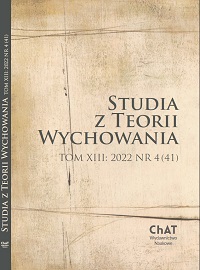Diagnoza pedagogiczna jak forma wsparcia uczniów w szkole w obliczu skutków pandemii
Pedagogical diagnosis as a form of support for school students in the wake of the pandemic
Author(s): Justyna NowotniakSubject(s): Social Sciences, Education
Published by: Wydawnictwo Naukowe ChAT
Keywords: pedagogical diagnosis; Comfort–Stretch–Panic model; remote learning
Summary/Abstract: This article presents a fragment of results of a research - its subject being “Diagnosing needs and expectations of students and teachers in primary schools in Szczecin days before returning to school” - conducted in May 2021 among 1125 students. Comfort-Stretch-Panic model, created by Karl Rohnke, has been used as a theoretical framework for said research. It has been shown that 18.6% of students function in high-to-extremely-high levels of panic, thus require aid - with 1 in 4 students stating that they can not receive such aid from their parents. Monitoring these children’s situation requires further systematic, multifaceted diagnosis.Given problem acts as a starting point towards discussion regarding the quality of pedagogical diagnosis in contemporary school, as well as means of its further improvement. W artykule zaprezentowano fragment wyników badania na temat „Diagnoza potrzeb i oczekiwań uczniów oraz nauczycieli szkół podstawowych w Szczecinie w przededniu powrotu do szkoły”, przeprowadzonego w maju 2021 roku (reprezentatywna próba 1125 uczniów). Ramą teoretyczną badań jest model Komfort–Napięcie–Panika (ang. Comfort–Stretch–Panic model), autorstwa Karla Rohnke. Wykazano, że 18,6% uczniów funkcjonuje w strefie Paniki na wysokim i bardzo wysokim poziomie i wymaga pomocy, tymczasem na wsparcia ze strony rodziców nie może liczyć co czwarty nastolatek. Monitorowanie sytuacji dzieci po powrocie do szkoły wymaga dalszej systematycznej, wieloaspektowej diagnozy. Problem ten stanowi przyczynek do rozważań o jakości diagnozy pedagogicznej we współczesnej szkole i możliwościach jej udoskonalenia.
Journal: Studia z Teorii Wychowania
- Issue Year: XIII/2022
- Issue No: 4 (41)
- Page Range: 157-172
- Page Count: 16
- Language: Polish

